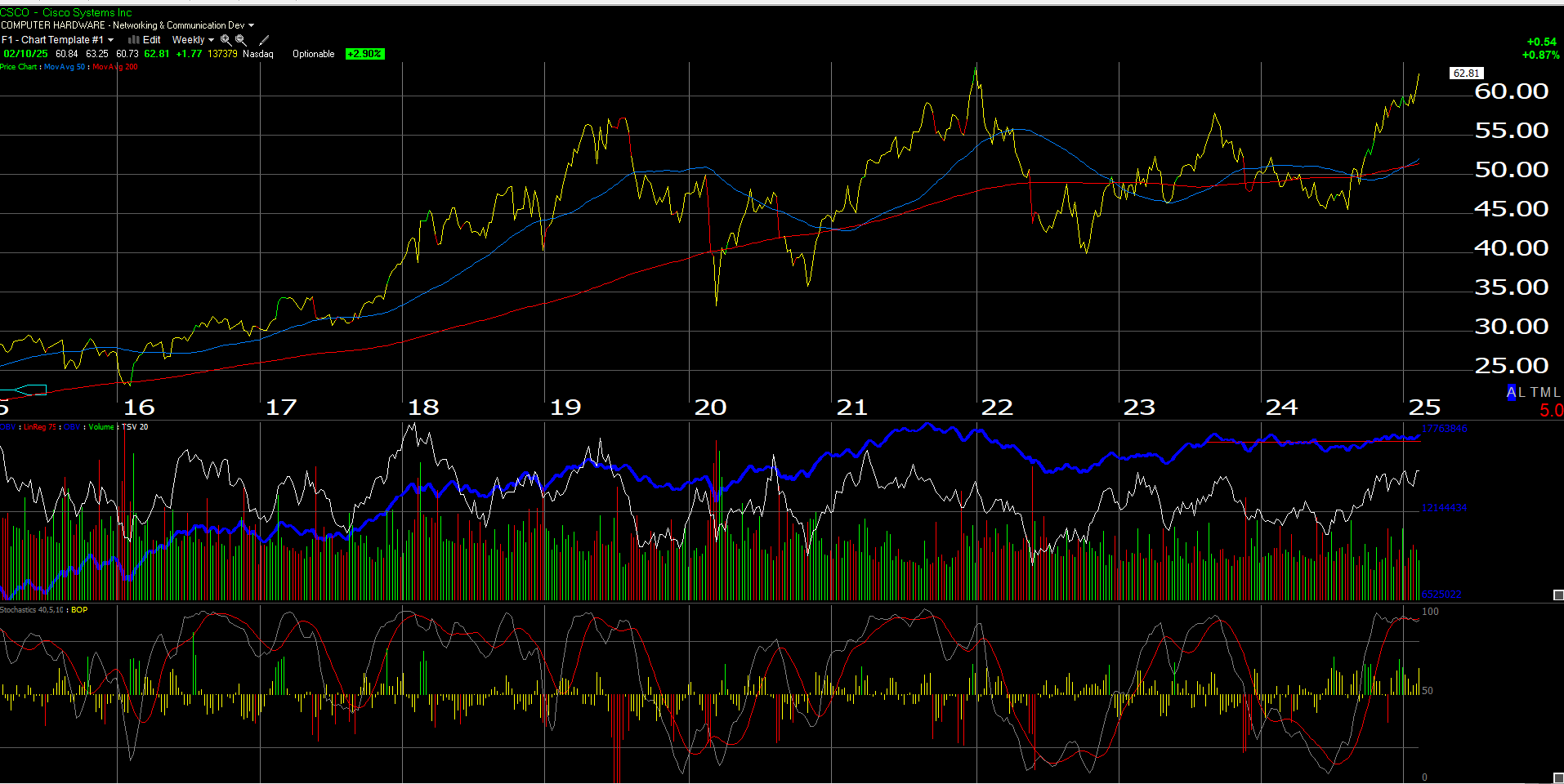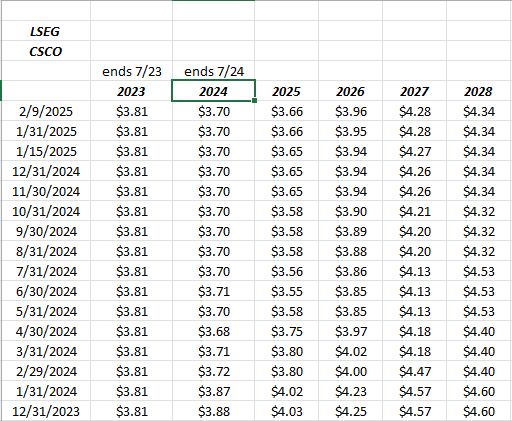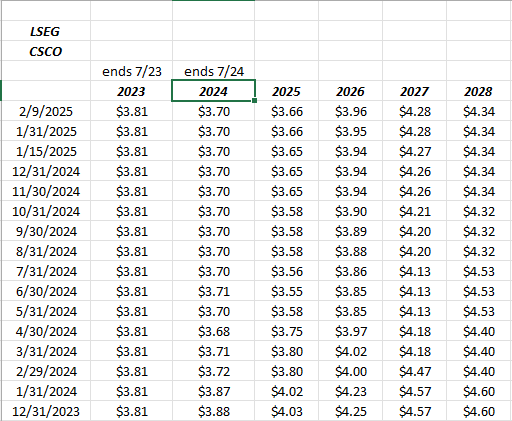Cisco Systems (NASDAQ:CSCO) reports their fiscal Q2 ’25 results after the closing bell on Wednesday, February 12th, 2025.
Analyst consensus is looking for $0.91 in earnings per share on $13.87 billion in revenue and $4.5 billion in operating income, for expected y-o-y growth of 5%, 7% and 8% respectively.
After 4 consecutive quarters of negative y-o-y growth thanks to inventory issues, if Cisco revenue does grow 8% y-o-y in this Q2 ’25 quarter, it will be the best quarter of y-o-y revenue growth since October ’23.
Full-year expected ’25 revenue and EPS is currently forecast to be $55.99 billion and $3.66 in EPS, for expected full-year growth of -2% and +1%. (Again, coming out of this networking inventory correction, and with easy compares, Cisco has seen a plethora of bad news the last few quarters.)
The networking giant does have easy compares over the next three quarters too.
The chart:

The most compelling aspect to Cisco is the chart. The stock is testing it’s December 30 ’21 post-2000 high of $64.28 on December 30 ’21.
During the 2022 correction / bear market, (whatever you wish to call it) Cisco fell from $64 to $40, but has recovered nicely since.
Cisco’s all-time-high print was $84 in April, 2000. If the stock should trade above $64.28 after Wednesday night’s earnings, Cisco will have reached it’s highest price level since that $84 print in April, 2000.
Cisco EPS estimate revisions:

Cisco’s EPS estimate revisions shows fiscal EPS peaking in late ’23, bottoming in the summer of ’24, and slowly rising since.

Cisco’s revenue estimates peaked near $59 billion per year in late ’23, and now hover around $55 – $56 billion for the 2025 fiscal year.
Valuation:
At $63 per share, Cisco is trading at 15x – 16x expected forward EPS, for expected average EPS growth the next three years of 5%, on 3% average revenue growth. Trading at 4.75x revenue and – well price-to-book- isn’t that meaningful, Cisco’s price-to-cash-flow and price-to-free-cash (per share) is 21x and 24x respectively.
Since this blog has been writing about earnings quality and how to judge a company’s earnings quality, CSCO’s cash-flow and free-cash-flow (FCF) versus the trailing twelve month (TTM) net income remains below 100%, but that’s with this inventory correction that has plagued Cisco the last 4 quarters. Prior to that period, Cisco’s TTM cash-flow and FCF were above 100% nicely.
Morningstar assigns a $50 fair value marker on Cisco, and maybe more interesting assigned a “wide moat” rating to the networking giant after years of a narrow moat.
This blog assigns a current fair value estimate on Cisco of $70, with the model based on a forward 4-quarter EPS estimate and an expected multiple. This fair value estimate is more volatile than Morningstar’s since the forward EPS estimates are constantly in flux.
Summary / conclusion:
The bull and bear case for Cisco seems straight-forward after the $24 billion Splunk (NASDAQ:SPLK) acquisition. The acquisition expands Cisco’s security (cybercrime) division to now being 15% of total revenue, after the security segment struggled for years in the mid-single-digits as a percentage of total Cisco revenue and annual revenue growth.
The networking division which is 50% of Cisco’s total revenue and is essentially the legacy business from the 1990’s has had a tough 4 quarters, with networking revenue revenue falling from a peak of $9.5 billion in July ’23 to October ’24’s quarterly networking revenue of $6.75 billion.
Cisco is not immune from the AI frenzy either: as a plus Cisco had $300 million in AI orders in fiscal Q1 ’25, and is on-track, per the conference call notes to book a $1 billion in orders in fiscal ’25.
Cisco requires extraordinary patience to be a shareholder: as was noted in the November ’24 Cisco earnings preview, Cisco has returned a little over 2% per year for shareholders since Jan 1, 2000, but +9.5% since January 1, 2010, both underperforming the SP 500.
Another consistent theme this blog has been talking about with readers and clients, is stocks like Cisco being “non-correlated” to the megacap 7 and megacap 10 names, and also to the semiconductor leadership, which you’d expect to conclude that the stock would hold it’s value better in any bear market, or even nasty correction, since it’s not necessarily a crowded trade, or part of the momentum trading group, however that wasn’t the case in 2022. Cisco fell 28% between January 1 ’22 through July 31, ’22, more than half the SP 500’s drop.
A stock that underperforms in both and bear markets – even corrections – becomes maddening to hold for clients.
Listen for the AI metrics as well Splunk numbers for this fiscal Q2 ’25.
Expectations are low for the quarter for Wednesday night’s release, and the stock is poised to trade at it’s highest level since late ’21, and prior to that, late 2000, early 2001.
***
None of this is advice or a recommendation, but only an opinion. Past performance is no guarantee of future results. Investing can and does involve the loss of money even for short periods of time. All Cisco eps and revenue data is sourced from LSEG.
